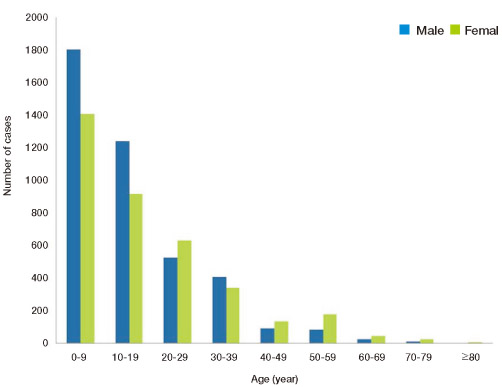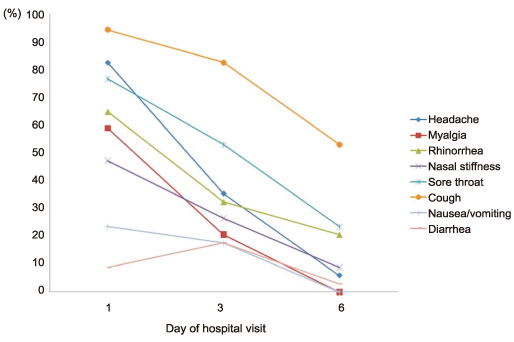Infect Chemother.
2010 Apr;42(2):69-75.
Epidemiological and Clinical Characteristics of Pandemic Influenza (H1N1 2009)
- Affiliations
-
- 1Division of Infectious Diseases, Department of Internal Medicine, Korea University College of Medicine, Seoul, Korea. heejinmd@medimail.co.kr
Abstract
- BACKGROUND
Since early outbreaks in North America in April 2009, the new influenza virus spread rapidly all over the world, and WHO declared a pandemic in June 2009. The objective of this article is to describe the epidemiological and clinical characteristics of patients confirmed with pandemic influenza (H1N1 2009).
MATERIALS AND METHODS
Among all patients confirmed with pandemic influenza (H1N1 2009) in Korea University Guro Hospital from 2 May 2009 to 31 March 2010, we selected 10% of patients aged more than 15 years randomly. Medical records were reviewed retrospectively and clinical findings were analyzed: social history, underlying disease, initial symptoms, and clinical course. Comparative analysis of initial symptoms was performed by time to presentation and age groups: 15-29 years, 30-49 years, 50-59 years, and more than 60 years. In addition, we described fatal cases of pandemic influenza (H1N1 2009).
RESULTS
From 2 May 2009 to 31 March 2010, total number of laboratory-confirmed cases of pandemic influenza (H1N1 2009) was 7,888. The most cases (1,632) developed at epidemic week 46, 2009. The median age of patients was 13 years and more than half of patients (55.4%) were less than 15 years. The median time to presentation was 1 day from onset of symptom. Clinical symptoms were cough (86.9%), sore throat (69.4%), myalgia (63.3%), chill (60.6%), rhinorrhea (57.7%), headache (57.6%), nausea or vomiting (27.4%), and diarrhea (9.3%). Fever was noted more frequently at 15-29 years group than > or =30 years group. Antiviral agent was administered to 274 patients (77.8%): 267 cases with oseltamivir and 7 cases with zanamivir. The median time to administration was 2 days and mean time to defervescence was 3 days. Cough was the most persistent symptom: initial visit (94.1%), on third day (82.4%), and on sixth day (52.9%) by the serial follow up at the same patients. Case fatality rate was 0.05%, and all fatal cases occurred in patients aged > or =50 years.
CONCLUSIONS
Children and adolescents were the most affected group. Clinical symptoms were similar to seasonal influenza. Gastrointestinal symptoms were relatively common, and cough was the most long-lasting symptom.
Keyword
MeSH Terms
Figure
Reference
-
1. Dawood FS, Jain S, Finelli L, Shaw MW, Lindstrom S, Garten RJ, Gubareva LV, Xu X, Bridges CB, Uyeki TM. Novel Swine-Origin Influenza A (H1N1) Virus Investigation Team. Emergence of a novel swine-origin influenza A (H1N1) virus in humans. N Engl J Med. 2009. 360:2605–2615.
Article2. KCDC. Cases of Influenza A (H1N1) infections in South Korea. Accessed 12 April 2010. Available at: http://www.cdc.go.kr/kcdchome/jsp/home/information/had/INFOHAD0001Detail.jsp?menuid=100053&appid=kcdchome&content=/contents/information/had/b/9261_view.html.3. Kim WJ. Epidemiologic and clinical characteristics of pandemic influenza (1918~2009). Infect Chemother. 2009. 41:Suppl 2. S5.4. Louie JK, Acosta M, Winter K, Jean C, Gavali S, Schechter R, Vugia D, Harriman K, Matyas B, Glaser CA, Samuel MC, Rosenberg J, Talarico J, Hatch D. California Pandemic (H1N1) Working Group. Factors associated with death or hospitalization due to pandemic 2009 influenza A(H1N1) infection in California. JAMA. 2009. 302:1896–1902.
Article5. KCDC. Influenza sentinel surveillance report. Accessed 13 April 2010. Available at: http://www.cdc.go.kr/kcdchome/jsp/observation/influenza/out/INFLOUT1200Detail.jsp?menuid=110253&appid=kcdcinfl&contentid=6286&pageNum=1&tabinx=1&sub=4&img1file=&img2file=&img3file=&html1file=&html2file=&html3file=&othfile=&idn=108581§ion=total&kwd=%ED%86%B5%ED%95%A9%EA%B2%80%EC%83%89%EC%96%B4%EB%A5%BC+%EC%9E%85%EB%A0%A5%ED%95%98%EC%84%B8%EC%9A%94&year=2009&week=45.6. World Health Organization. CDC protocol of realtime RTPCR for influenza A(H1N1). Accessed 10 April 2010. Available at: http://www.who.int/csr/resources/publications/swineflu/realtimeptpcr/en/index.html.7. World Health Organization. Changes in repor ting requirements for pandemic (H1N1) 2009 virus infection. Accessed 10 April 2010. Available at: http://www.who.int/csr/disease/swineflu/notes/h1n1_surveillance_20090710/en/index.html.8. Sullivan SJ, Jacobson RM, Dowdle WR, Poland GA. 2009 H1N1 influenza. Mayo Clin Proc. 2010. 85:64–76.
Article9. Chilean Task Force for study of Pandemic Influenza A (H1N1). Pedroni E, Garcia M, Espinola V, Guerrero A, Gonzalez C, Olea A, Calvo M, Martorell B, Winkler M, Carrasco M, Vergara J, Ulloa J, Carrazana A, Mujica O, Villarroel J, Labrana M, Vargas M, Gonzalez P, Caceres L, Zamorano C, Momberg R, Munoz G, Rocco J, Bosque V, Gallardo A, Elgueta J, Vega J. Outbreak of 2009 pandemic influenza A(H1N1), Los Lagos, Chile, April-June 2009. Euro Surveill. 2010. 15:pii:19456.10. Lee DH, Kim JS, Kim CW, Kim SE, Lee SJ, Park YS. Characteristics of diagnosed novel Influenza A (H1N1) cases in the community sentinel hospital and usefulness of clinical diagnosis. Korean J Fam Med. 2010. 31:115–123.
Article11. Crum-Cianflone NF, Blair PJ, Faix D, Arnold J, Echols S, Sherman SS, Tueller JE, Warkentien T, Sanguineti G, Bavaro M, Hale BR. Clinical and epidemiologic characteristics of an outbreak of novel H1N1 (swine origin) influenza A virus among United States military beneficiaries. Clin Infect Dis. 2009. 49:1801–1810.
Article12. To KK, Chan KH, Li IW, Tsang TY, Tse H, Chan JF, Hung IF, Lai ST, Leung CW, Kwan YW, Lau YL, Ng TK, Cheng VC, Peiris JS, Yuen KY. Viral load in patients infected with pandemic H1N1 2009 influenza A virus. J Med Virol. 2010. 82:1–7.
Article13. Ling LM, Chow AL, Lye DC, Tan AS, Krishnan P, Cui L, Win NN, Chan M, Lim PL, Lee CC, Leo YS. Effects of early oseltamivir therapy on viral shedding in 2009 pandemic influenza A (H1N1) virus infection. Clin Infect Dis. 2010. 50:963–969.
Article14. Donaldson LJ, Rutter PD, Ellis BM, Greaves FE, Mytton OT, Pebody RG, Yardley IE. Mortality from pandemic A/H1N1 2009 influenza in England: public health surveillance study. BMJ. 2009. 339:–b5213.
Article15. World Health Organization. Clinical features of severe cases of pandemic influenza. Accessed 10 April 2010. Availavle at: http://www.who.int/csr/disease/swineflu/notes/h1n1_clinical_features_20091016/en/index.html.16. Kumar A, Zarychanski R, Pinto R, Cook DJ, Marshall J, Lacroix J, Stelfox T, Bagshaw S, Choong K, Lamontagne F, Turgeon AF, Lapinsky S, Ahern SP, Smith O, Siddiqui F, Jouvet P, Khwaja K, McIntyre L, Menon K, Hutchison J, Hornstein D, Joffe A, Lauzier F, Singh J, Karachi T, Wiebe K, Olafson K, Ramsey C, Sharma S, Dodek P, Meade M, Hall R, Fowler RA. Canadian Critical Care Trials Group H1N1 Collaborative. Critically ill patients with 2009 influenza A(H1N1) infection in Canada. JAMA. 2009. 302:1872–1879.
Article
- Full Text Links
- Actions
-
Cited
- CITED
-
- Close
- Share
- Similar articles
-
- The 2009 H1N1 Pandemic Influenza in Korea
- Influenza Associated Pneumonia
- Epidemiology, clinical manifestations, and management of pandemic novel Influenza A (H1N1)
- Clinical and Laboratory Characteristics of Pandemic Influenza A/H1N1 2009 Infection among Patients with Malignancy in Korea
- A Case of Pandemic 2009 H1N1 Influenza A Manifestation as Apical Ballooning Syndrome




